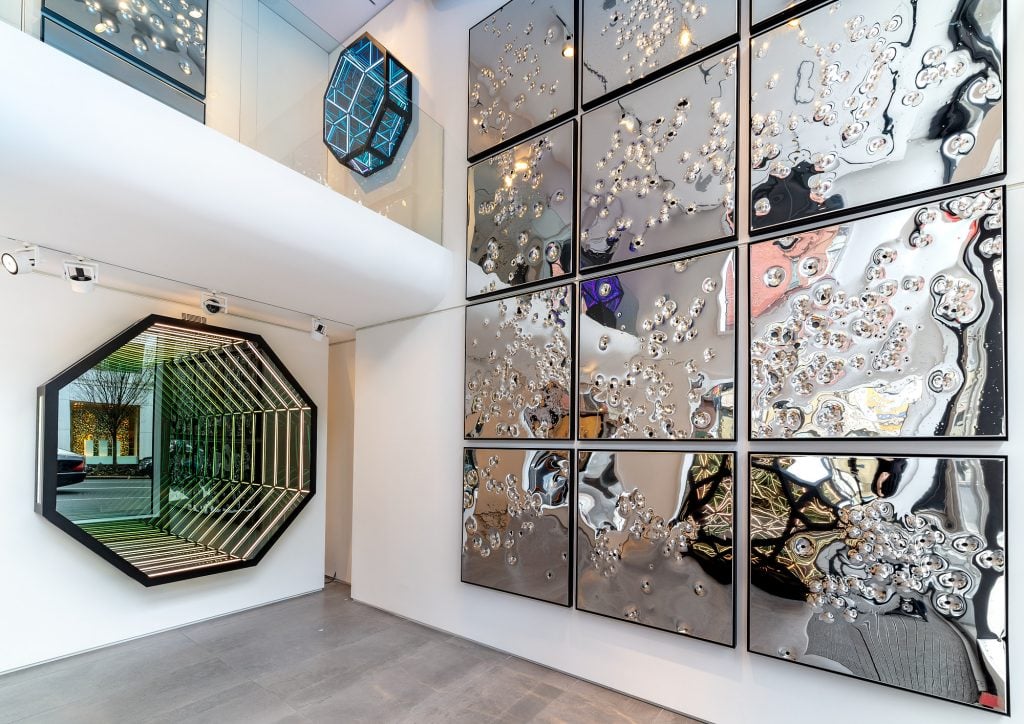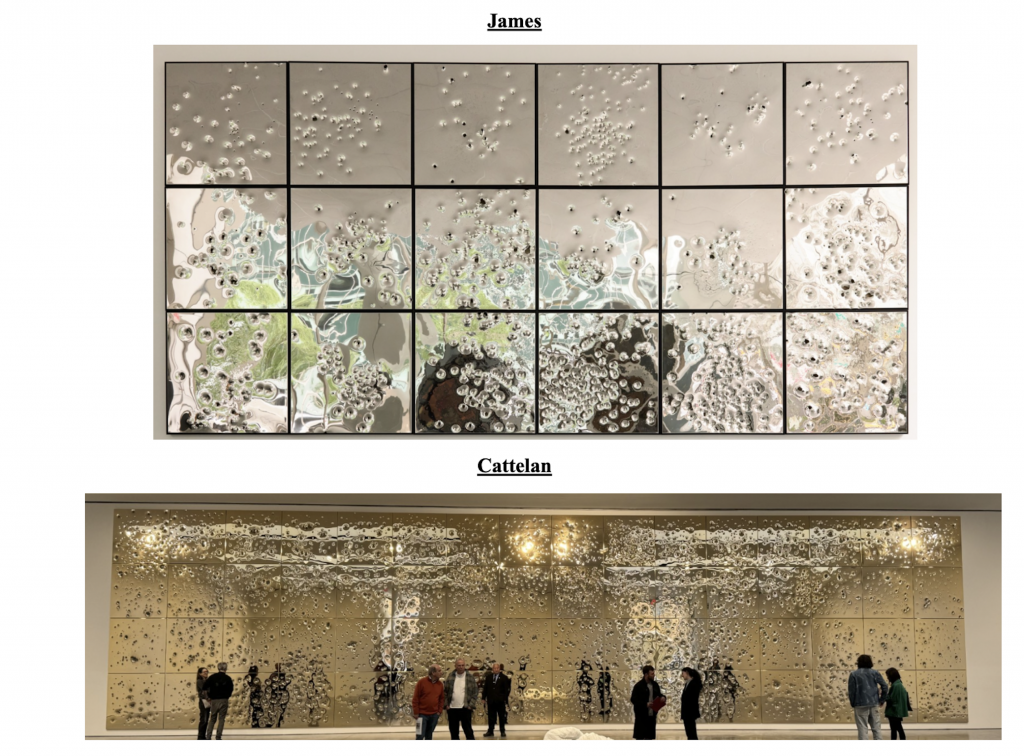Law & Politics
Artist Anthony James Shoots Maurizio Cattelan a Legal Missive Over Near-Identical Works
Both consist of sheets of shiny metal pockmarked with bullet holes.

Both consist of sheets of shiny metal pockmarked with bullet holes.

Brian Boucher

Two shows of remarkably similar works by artists Maurizio Cattelan and Anthony James opened on the same day in New York recently, and now Cattelan is for the latest time on the receiving end of an angry letter from a lawyer.
The works consist of large panels of reflective metal—mirror-polished stainless steel in James’s Bullet Paintings, gold in Cattelan’s Sunday—that have been pockmarked by gunfire. James has been creating these works for a decade, while this is the first piece in this vein from Cattelan.
“There’s no chance that he hasn’t seen them or that they haven’t come to his attention,” James said just before their dueling shows opened, as first reported by Artnet News.
The five-page letter, from Scott Allan Burroughs of law firm Doniger Burroughs, of New York and Venice, California, pointed out that the Copyright Act “[protects] an artist’s expression of an idea” even if it does not protect ideas.
Burroughs cited the landmark 1992 decision Rogers v. Koons, in which another world-famous artist, Jeff Koons, lost a legal contest with the author of a photograph he appropriated to create his sculpture String of Puppies. According to that decision, it’s only when the points of dissimilarity exceed those that are similar and that the similar areas are relatively unimportant that the defendant can win. The similarities here, according to Burroughs, “relate to virtually all of the creative decisions apparently made in creating and fabricating the works.”

Installation view of “Anthony James: Divine Infinity,” 2022. Courtesy of Opera Gallery, New York.
The letter makes several requests. It asks that Cattelan “relate to us the creative process for Sunday.” The lawyer also wants to know if James is right that Cattelan or someone in his circle had seen his sculptures. “Please,” the letter said, “also describe the inspiration for Sunday and… provide your thoughts as to the striking similarities between Sunday and Bullet Painting.”

Side-by-side images of the work of Anthony James and Maurizio Cattelan, from a letter to Cattelan’s gallery, Gagosian.
As it happens, Cattelan has already fulfilled the last request in a way, when he spoke to the New Yorker’s Calvin Tomkins about the dustup. Cattelan, wrote Tomkins, “declined to comment publicly, but in private he said, ‘I’m very surprised. The resemblance is uncanny. All I can say is good luck to both of us.’”
In response, James said, “I agree, it is uncanny. The chance that both of us came up with nearly identical iterations of the same concept is nearly impossible.”
James, furthermore, believes Cattelan has harmed his market, saying that he’s known for this particular work and that the arrival of Sunday on the scene has sown “confusion.” Market insiders say that Cattelan’s panels are individually priced at $375,000; James’s go for $40,000 each.
A spokesperson for Gagosian said: “We have received the letter and disagree with the allegations.”
Francesco Bonami, who curated the Gagosian show, took aim at James’s complaints. “[Cattelan] didn’t know [James’s work]. He didn’t see it. This work is about the meaning. The other guy doesn’t have the same meaning. A crucifixion is a cross with a guy nailed. And they’ve been doing it from the 3rd century until now. No one complained about someone copying someone else. It’s ridiculous to say, ‘I did that before other people,’” he told Artnet News’s Katya Kazakina.
The hurdle James would have to mount, pointed out attorney Sergio Muñoz Sarmiento, is that ideas are not copyrightable, even if the results look very similar. As an analogy, Sarmiento offered a hypothetical artist saying, “‘Let’s put the canvas on the ground and splatter it.’ It’s going to look like a Pollock,” he said, “but it’s not infringement.”
Counting against Cattelan, at the same time, is the fact that James has exhibited his work in major art-world capitals like New York and Milan. “Artists love to go to gallery shows,” said Sarmiento, “so I can see a court saying that we can presume that Cattelan saw it.” (Cattelan divides his time between the two cities.)
Writing in Artnet News, Andrew Russeth was unimpressed with Sunday, calling it “a fairly obvious representation of America’s twin obsessions: money and violence” and saying that the panels could be “generously” compared to work by Lucio Fontana before concluding: “The less said about them, the better.”
Cattelan has faced similar accusations before and shot them full of holes. After he emerged from retirement in 2019 to unveil the runaway viral hit Comedian, consisting of a banana duct-taped to a wall, artist Joe Morford brought a copyright complaint, saying Cattelan’s piece was too close to his own work Banana and Orange. Cattelan successfully defended himself, saying he’d never heard of the guy.
French artist Daniel Druet, in 2022, also tried to get a bite of the banana, as it were, suing the Italian artist and claiming that Cattelan had robbed him of his intellectual property, alleging that nine of Cattelan’s best-known works were based on his wax models. Druet claimed that he was the “exclusive author” of the pieces and sought €5 million ($5.25 million at that time) in compensation. Cattelan argued that the ideas and concepts were his own, and a French court dismissed the case, stating Druet misfired by suing the artist’s gallery, Perrotin, and not the artist.
Many artists have created artworks by firing guns at various targets, from William S. Burroughs to Niki de Saint Phalle and Zhao Zhao. There are also several who have created works by firing guns into reflective metal panels, such as Kader Attia, Angelo Brescianini, Margaret Evangeline, Jochem Hendricks, and Mao Tongqiang.
James acknowledges that other artists have used similar materials. “I’m in no way claiming that others haven’t done, or can’t do, work incorporating bullet holes,” he said. “My concern is the similarities in the expressions here.”
In the end, James says he wants to work it out. “A satisfactory outcome would be us, as artists, coming together to talk this through and reach a resolution.”